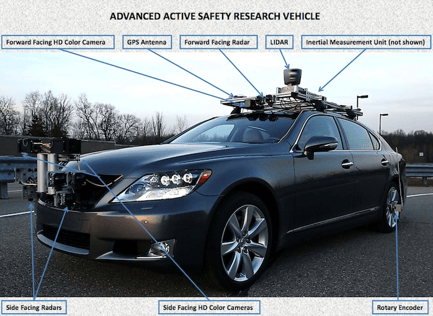What's new in Robotics this week - Sept 11

Posted on Sep 14, 2015 in Robotics, Robots, News
5 min read time
Hacking autonomous cars' LIDARs; Will Subdrones Cause WWIII?; Pepper takes one for the team (what are the HRI implications?); Meet the robot that builds robots and more.
Researcher Hacks Self-driving Car Sensors (IEEE Spectrum)
Serious security vulnerabilities with the LIDAR used in most autonomous vehicles were revealed this week by Jonathan Petit, Principal Scientist at software security company Security Innovation.

Photo: Jeff Kowalsky/Corbis
As Mark Harris reports:While the short-range radars used by many self-driving cars for navigation operate in a frequency band requiring licensing, lidar systems use easily-mimicked pulses of laser light to build up a 3-D picture of the car’s surroundings and were ripe for attack.
Petit began by simply recording pulses from a commercial IBEO Lux lidar unit. The pulses were not encoded or encrypted, which allowed him to simply replay them at a later point. “The only tricky part was to be synchronized, to fire the signal back at the lidar at the right time,” he says. “Then the lidar thought that there was clearly an object there.”
While working in the University of Cork's Computer Security lab, Petit was able to create the illusion of a fake car, wall, or pedestrian anywhere from 20 to 350 meters from the lidar unit, and make multiple copies of the simulated obstacles, and even make them move.
And he was able to do it with a USD$60 Raspberry Pi and a laser pointer.
In February, The Guardian ran a story on an investigation initiated by Massachusetts Senator Edward Markey:
According to Markey, nearly 100% of cars on the market include wireless technologies that could pose vulnerabilities to hacking or privacy intrusions, while most automobile manufacturers are unaware of or unable to report on past hacking incidents.
The senator also said security measures to prevent remote access to vehicle electronics are inconsistent and haphazard across all automobile manufacturers...
The Senator will surely be concerned by the latest hack, but are there deeper design issues at play?
Consider this: if you throw say a large inflatable object in front of a car being driven by a human, is it safe to say that the human may or may not stop, depending on the road conditions? I think so. But can we say the same of autonomous cars? Or is it the case that autonomous vehicles will stop every single time and how can designers get around this?
Will Subdrones Cause World War III? (Defense One)
This excellent article by Patrick Tucker picks up on some of the issues raised by the UNIDIR report (PDF) on maritime military robots linked to in the last installment of "Picks of the Week".
Whereas the Predator or Reaper [drones] rely on the Global Positioning System, most underwater vessels can’t pick up GPS. A greater level of autonomy, in many instances, isn’t just an asset but a necessity of basic operation. That’s especially true for systems built to stay in the water for years at a time.
Just as militaries are working to establish a more permanent presence at sea, especially in today’s contested waters in the Pacific and Persian Gulf, they’re also looking to do so in newly accessible waters northward. Here’s where armed naval robots, the competing interests of naval powers, and an absence of clear law could be explosive.
"Years at a time" is key here: how easy it is to retrieve these machines from the ocean when they are no longer needed is a key issue. If autonomous military robots are difficult to retrieve or are simply abandoned, then will we be facing a maritime version of the land-mine problem in decades to come? 
Pepper robot. The lesson for end-users is "Please stick to broccoli in future."
Photo: Jill Giardino
Drunken Kanagawa man arrested after kicking SoftBank robot (Japan Times)
This story should spice up a few of our ideas about human-robot interaction.
As reported by The Japan Times, a drunken customer attacked a Pepper robot at a Softbank Corp. store Sunday in a fit of pique with a store clerk.
Pepper is billed as an emotion reading robot, which leaves some questions to be answered and makes me quite curious to see the robot's data for the time period preceding and during the attack.
While the media has covered this story as a simple human vs. robot attack, it's actually more complicated than that as the source of the attacker's anger was not the robot itself, but another human.
The transference of anger from a human to a robot is noteworthy.
It is also a good thing --at least in this case-- because although the robot was damaged the store clerk was unhurt.
Either way, Pepper took one for the team. (And is apparently still functional, which is more than can be said for poor old Hitchbot, the robot that was attacked by unknown parties last August in Philadelphia.)
Robot ethics expert Kate Darling from MIT's Media Lab, published a fascinating story on IEEE Spectrum in August, about how observing groups of children mistreating a robot led Japanese researchers to create a new escape maneuver system. The researcher's paper "Why Do Children Abuse Robots?" is available here in PDF.
Meet The Robot That Builds Robots (WBUR)
Nice audio and video from Boston's NPR station about a Cambridge University-designed robot that can design, build, and test robots based on principles of "natural selection."
AND FINALLY....
This 2013 photo shows a prototype autonomous vehicle from Toyota. Credit: Toyota
Toyota Invests $50 Million In Artificial Intelligence Research For Vehicle Robotics (Forbes); Who Will Own the Robots? (MIT Technology Review); ICARUS: European Union Moves Robot-Assisted Search and Rescue Forward! (CRASAR)









Leave a comment